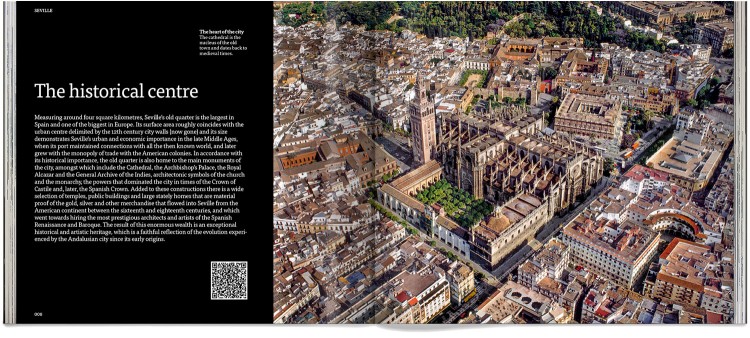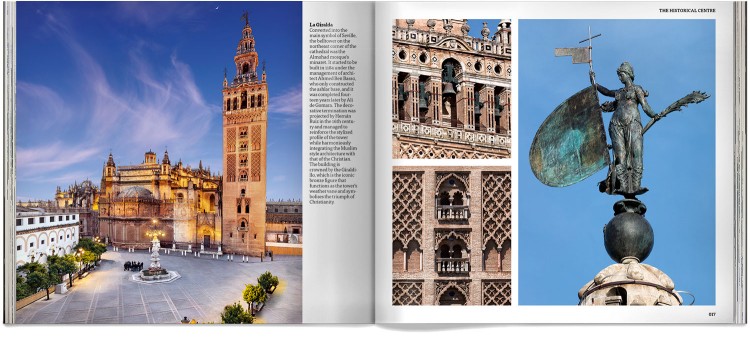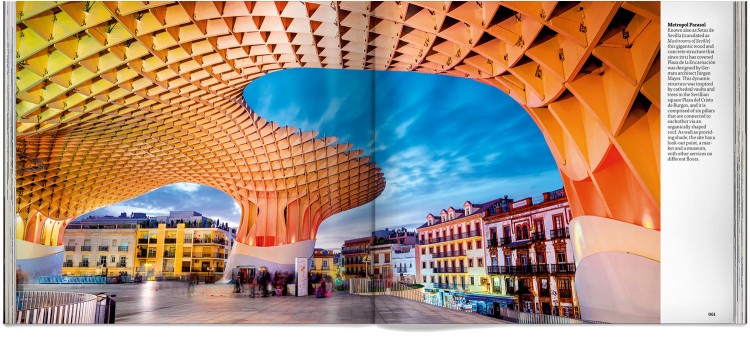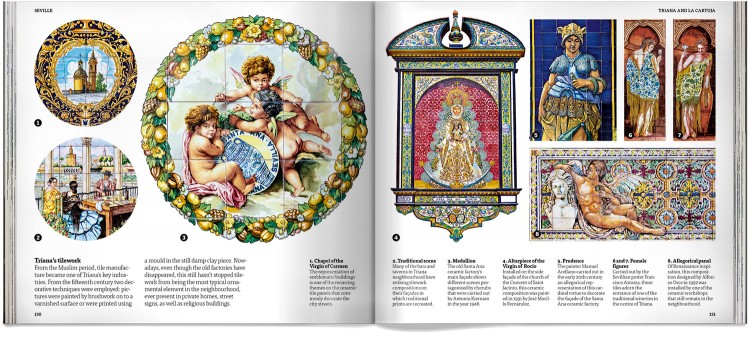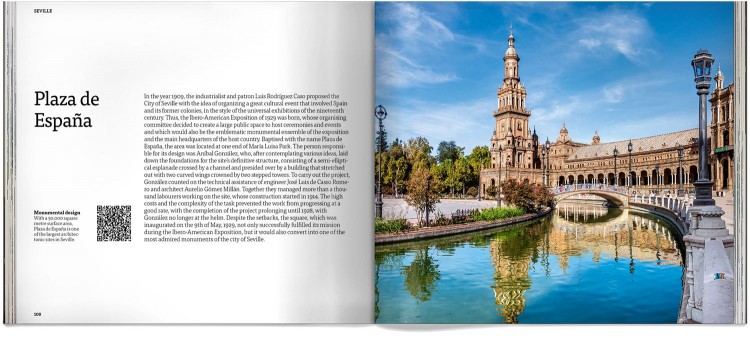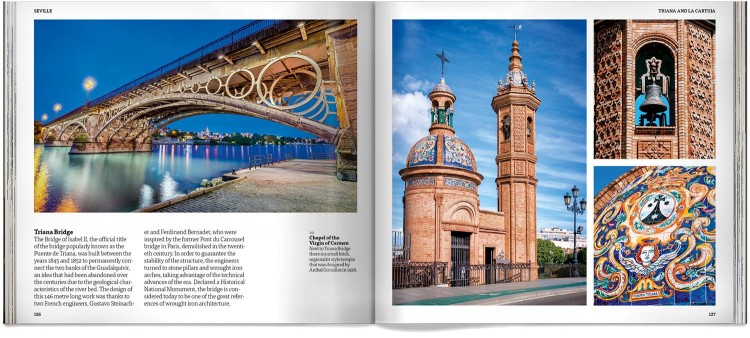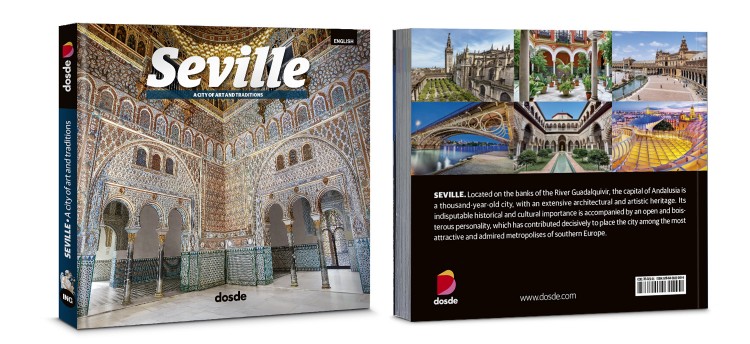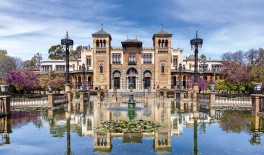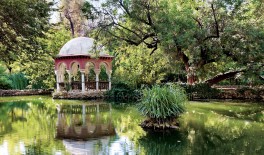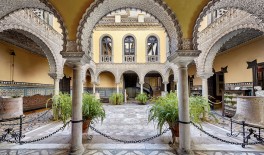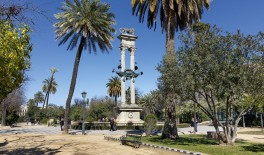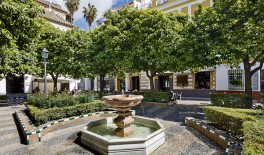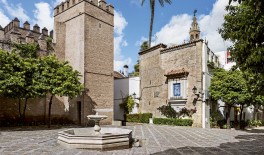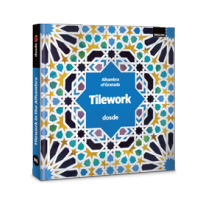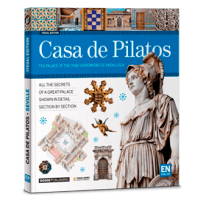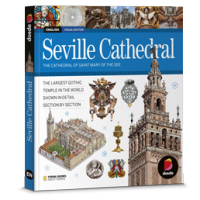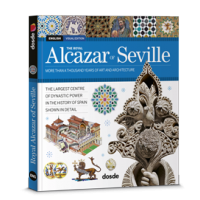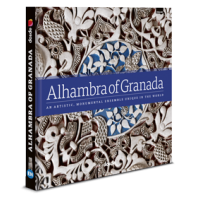Seville
A monumental city
RETURN
About the book Sevilla
This book on Seville is a detailed photographic tour of the most important monuments in the city. Its pages cover the most important sites, the most embematic monuments and the city's abundant art and architectural heritage.
The book published by Dosde includes more than 230 photos of Seville that capture the many nooks and crannies of a majestic city that attracts thousands of visitors every year. Each chapter shows off the most representative zones of the Andalusian capital, including the neighbourhoods in the Old Quarter, such as Santa Cruz and the Arenal, as well as La Macarena district, Plaza de España and Triana, amongst other places, providing a global view of the city.
Likewise, the book explores the history of the city's main monuments, such as the Royal Alcazar of Seville and the Cathedral of Saint Mary of the See, and its numerous palaces, amongst which include Casa de Pilatos, Palacio de las Dueñas or Casa de Salinas.
Apart from numerous pictures of Seville, the book includes explanatory texts about the city's past and present, packed with information and fascinating facts. A book that is an absolute must to discover Seville from a privileged angle, complemented by other titles included in the book collection on Spanish cities already published by Dosde such as our photobook on Bilbao and our photobook on Madrid.
The book published by Dosde includes more than 230 photos of Seville that capture the many nooks and crannies of a majestic city that attracts thousands of visitors every year. Each chapter shows off the most representative zones of the Andalusian capital, including the neighbourhoods in the Old Quarter, such as Santa Cruz and the Arenal, as well as La Macarena district, Plaza de España and Triana, amongst other places, providing a global view of the city.
Likewise, the book explores the history of the city's main monuments, such as the Royal Alcazar of Seville and the Cathedral of Saint Mary of the See, and its numerous palaces, amongst which include Casa de Pilatos, Palacio de las Dueñas or Casa de Salinas.
Apart from numerous pictures of Seville, the book includes explanatory texts about the city's past and present, packed with information and fascinating facts. A book that is an absolute must to discover Seville from a privileged angle, complemented by other titles included in the book collection on Spanish cities already published by Dosde such as our photobook on Bilbao and our photobook on Madrid.
Photo Edition
Seville
Official product
Made with environmentally friendly paper
Multilanguage: Available in 8 languages
More than 220 top quality photographs
About the book Sevilla
This book on Seville is a detailed photographic tour of the most important monuments in the city. Its pages cover the most important sites, the most embematic monuments and the city's abundant art and architectural heritage.
The book published by Dosde includes more than 230 photos of Seville that capture the many nooks and crannies of a majestic city that attracts thousands of visitors every year. Each chapter shows off the most representative zones of the Andalusian capital, including the neighbourhoods in the Old Quarter, such as Santa Cruz and the Arenal, as well as La Macarena district, Plaza de España and Triana, amongst other places, providing a global view of the city.
Likewise, the book explores the history of the city's main monuments, such as the Royal Alcazar of Seville and the Cathedral of Saint Mary of the See, and its numerous palaces, amongst which include Casa de Pilatos, Palacio de las Dueñas or Casa de Salinas.
Apart from numerous pictures of Seville, the book includes explanatory texts about the city's past and present, packed with information and fascinating facts. A book that is an absolute must to discover Seville from a privileged angle, complemented by other titles included in the book collection on Spanish cities already published by Dosde such as our photobook on Bilbao and our photobook on Madrid.
The book published by Dosde includes more than 230 photos of Seville that capture the many nooks and crannies of a majestic city that attracts thousands of visitors every year. Each chapter shows off the most representative zones of the Andalusian capital, including the neighbourhoods in the Old Quarter, such as Santa Cruz and the Arenal, as well as La Macarena district, Plaza de España and Triana, amongst other places, providing a global view of the city.
Likewise, the book explores the history of the city's main monuments, such as the Royal Alcazar of Seville and the Cathedral of Saint Mary of the See, and its numerous palaces, amongst which include Casa de Pilatos, Palacio de las Dueñas or Casa de Salinas.
Apart from numerous pictures of Seville, the book includes explanatory texts about the city's past and present, packed with information and fascinating facts. A book that is an absolute must to discover Seville from a privileged angle, complemented by other titles included in the book collection on Spanish cities already published by Dosde such as our photobook on Bilbao and our photobook on Madrid.
Videos Seville
No reviews yet.
Additional Information
- Additional Information
- Subtitle: A monumental city
- Weight (g): 420
- Binding: Paperback with flaps
- Size (cm): 19,5 x 17,5
- Author: Dosde
- Pages: 0
- Edition: Photo Edition
What to see in Seville
In 1248 King Ferdinand III of Castile conquered the city and repopulated it with Christians and Jews. From then on, Seville was closely associated with the monarchy and started expanding on what was already established following the discovery of America, when the city was chosen to accommodate the House of Trade, created in 1503 to administer trade and relations with the New World.
Seville received an important boost in the twentieth century thanks to two major events of international resonance: the Ibero-American Exposition of 1929 and the Universal Exposition of 1992, for which numerous Public Works were carried out. The Andalusian capital was able to reinvent itself as a modern and dynamic city, completely renewed thanks to its strong economic and cultural fabric.
Measuring around four square kilometres, Seville’s old quarter is the largest in Spain and one of the biggest in Europe. This is where the main monuments of the city can be found, amongst which include the Cathedral, the Archbishop’s Palace, the Royal Alcazar and the General Archive of the Indies, architectonic symbols of the church and the monarchy.
Added to these constructions are wide selection of temples, public buildings and large stately homes, which make up an exceptional historical and artistic heritage.
In medieval Spanish cities, the Hebrew community, who played an important social and economic role, lived in their own separate neighbourhoods, the so-called Juderías. In Seville, part of the local Jewish community settled in the current district of Santa Cruz. Synagogues and workshops alternated in the maze of streets of a district that reached its maximum splendour in the mid- fourteenth century.
This period of peace and prosperity unfortunately ended in 1391, when a violent popular revolt against the Jewish population caused numerous deaths and provoked the exodus of part of the Hebrew community, whom in 1483 were definitively expelled from Seville. With the arrival of the Ibero-American Exposition in 1929, the neighbourhood underwent a radical transformation thanks to the opening and expansion of streets and the renewal of squares, interventions that gave Santa Cruz its current picturesque appearance.
By the first half of the nineteenth century, the demolition of various religious buildings meant that new squares and gardens could be created. Today, all this sector constitutes the administrative and commercial heart of Seville and boasts many official institutions such as the City Hall, as well as some of the city’s busiest streets, places packed with history and monumental architecture, where the business and leisure activities of the Sevillians take place.
Despite the setbacks, the square not only successfully fulfilled its mission during the Ibero-American Exposition, but it would also convert into one of the most admired monuments of the city of Seville.
Seville received an important boost in the twentieth century thanks to two major events of international resonance: the Ibero-American Exposition of 1929 and the Universal Exposition of 1992, for which numerous Public Works were carried out. The Andalusian capital was able to reinvent itself as a modern and dynamic city, completely renewed thanks to its strong economic and cultural fabric.
The historical centre
Measuring around four square kilometres, Seville’s old quarter is the largest in Spain and one of the biggest in Europe. This is where the main monuments of the city can be found, amongst which include the Cathedral, the Archbishop’s Palace, the Royal Alcazar and the General Archive of the Indies, architectonic symbols of the church and the monarchy.Added to these constructions are wide selection of temples, public buildings and large stately homes, which make up an exceptional historical and artistic heritage.
Santa Cruz
In medieval Spanish cities, the Hebrew community, who played an important social and economic role, lived in their own separate neighbourhoods, the so-called Juderías. In Seville, part of the local Jewish community settled in the current district of Santa Cruz. Synagogues and workshops alternated in the maze of streets of a district that reached its maximum splendour in the mid- fourteenth century.This period of peace and prosperity unfortunately ended in 1391, when a violent popular revolt against the Jewish population caused numerous deaths and provoked the exodus of part of the Hebrew community, whom in 1483 were definitively expelled from Seville. With the arrival of the Ibero-American Exposition in 1929, the neighbourhood underwent a radical transformation thanks to the opening and expansion of streets and the renewal of squares, interventions that gave Santa Cruz its current picturesque appearance.
The city centre
The cathedral and its surroundings already constituted the centre of Muslim Seville. During the Middle Ages and the Modern Age, all this area was subject to intense building activity. Luxurious palaces were erected for aristocrats and the local bourgeoisie, as well as the simpler houses which were home to families from more modest backgrounds. Likewise, numerous convents and churches were founded, as a reflection of the fundamental role played by the religious establishment at the time.By the first half of the nineteenth century, the demolition of various religious buildings meant that new squares and gardens could be created. Today, all this sector constitutes the administrative and commercial heart of Seville and boasts many official institutions such as the City Hall, as well as some of the city’s busiest streets, places packed with history and monumental architecture, where the business and leisure activities of the Sevillians take place.
Plaza de España of Seville
With a 50,000 square metre surface area, Plaza de España is one of the largest architectonic sites in Seville. Its origins go back to the hosting of the Ibero-American Exposition of 1929, where a large public space was planned to hold events and ceremonies. The person responsible for its design was Aníbal González accompanied by around a thousand labourers working on the construction, which actually took 14 years to complete due to the project's complexity.Despite the setbacks, the square not only successfully fulfilled its mission during the Ibero-American Exposition, but it would also convert into one of the most admired monuments of the city of Seville.

